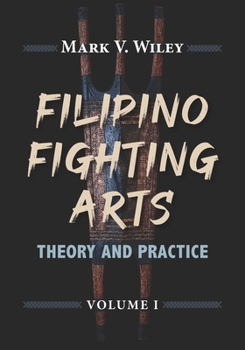Filipino Fighting Arts: Theory and Practice
The fighting arts of the Philippines are so vast and dynamic that few are able to grasp the true scope and essence of their training methods, techniques and fighting strategies. With this in mind, Mark Wiley, a renowned expert on Filipino martial arts, set out to write a book on the Filipino systems that would offer a structured comparison of 25 Filipino systems in terms of their training methods and progressions, fighting concepts, theories and strategies. In researching this book, Mark traveled to the Philippines a dozen times to meet and train with the masters and to uncover the secrets of these deadly arts. Profusely illustrated with over 500 photographs, this book reveals the incredible diversity of the martial arts which thrive today in the Philippines. Many of the photographs and much of the information in this book have never before been presented to the world at large.
Format:Paperback
Language:English
ISBN:1943155356
ISBN13:9781943155354
Release Date:November 2020
Publisher:Tambuli Media
Length:310 Pages
Weight:1.19 lbs.
Dimensions:0.7" x 7.0" x 10.0"
Customer Reviews
5 ratings
Great Comparative Book
Published by Thriftbooks.com User , 17 years ago
This book gives an excellent insight into the various forms of Filipino Fighting Arts. It examines 27 different styles, giving a brief description of the history of the style, training progressions, training methods, fighting strategies and free sparring. The only downfall of the book is that due to the wide range of styles discussed, it does not go into depth on any of the styles. However, once you obtain this background, you can then select books that are more in depth on a particular style. I enjoyed see the stylistic difference and learned some of the background of each style.
Good book, but not everyone is in it
Published by Thriftbooks.com User , 19 years ago
This is a very good book about kali and Filipino martial arts. I wish that there would have been chapters on Villebrille, John LaCosta, and Tuhon Leo Gaje, three of the main Filipino M.A. greats. Maybe in the next edition.
A New and Different FMA book by Wiley...
Published by Thriftbooks.com User , 22 years ago
In the introduction of his third book, Author Mark Wiley states that his purpose is not to rehash materials already presented in his previous two books ("Filipino Martial Arts: Cbalas Cerrada Escrima" (1994), and Filipino Martial Culture" (1996)). Unlike his volume "Filipino Martial Culture", the focus of this writing is on 27 different specific Filipino arts, rather than the history of the masters or organizations which propagate them.Wiley admits his work is not exhaustive, but it is (as I write) the most exhaustive guide to concern itself with he stylistic differences between different schools of Filipino arts. Wiley describes training, training methods, theory, fighting concepts and progressions, strategies, and photographic depictions of fighting techniques. You will gain as I did, a better understanding of the similarities and differences between different schools, from practice and theory to custom and tradition. The closest I have come to seeing a collection Like Wiley's is the out-of-print book, "Masters of Arnis, Kali and Ecrima" written by Edgar Sulite of the Bakbakan, which focused on teachers and styles of Filipino fighting. It is nice to be in the middle of the Filipino arts renaisance, and finally have the resources available to understand these practical combative methods.
Filipino Fighting Arts: Theory and Practice
Published by Thriftbooks.com User , 23 years ago
Fantastic. Mr. Wiley has outdone himself. His previous works were terrific. This one picks up were "Martial Culture" left off. A must have for all those involved in the filipino combatives and anyone mildly interested in the eastern martial disciplines. Well written full of well documented research. Will be on my gift list.
An excellent visual overview FMA
Published by Thriftbooks.com User , 24 years ago
I just recently began training with the Bakbakan to learn arnis, and this book was a great guide to the various arts that are out there. To really see the quality of this book, you must read the author's introduction: Mark Wiley will only write about arts that he has had hands on experience with, or has personally interviewed the masters of said art. He relies only on primary sources, thus, Filipino Fighting Arts becomes a terrific reference work. The same can be said of his earlier work, Filipino Martial Culture. The only drawback to this volume is that it is nearly impossible to capture the free-flowing effectiveness of Filipino martial arts in photographs. Without prior knowledge of the movements used in these arts, it might be difficult to understad exactly the manner in which the moves are executed.






